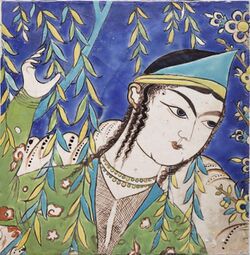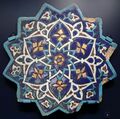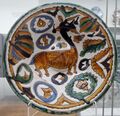Engineering:Cuerda seca

Cuerda seca (Spanish for "dry cord") is a technique used when applying coloured glazes to ceramic surfaces.
Description
When different coloured glazes are applied to a ceramic surface, the glazes have a tendency to run together during the firing process. In the cuerda seca technique, the water-soluble glazes are separated on the surface by thin lines of a greasy substance to prevent them running out of their delineated areas. A dark pigment such as manganese carbonate is usually mixed with the grease to produce a dark line around each coloured area.[1]
History
The origin of the technique is not known for certain. Many scholars believe that the cuerda seca technique originated primarily in al-Andalus (Islamic Spain and Portugal) in the second half of the 10th century, during the Umayyad period (citing Umayyad-era examples from Suza).[2][3][4][5] Scholar Juan Zozaya argues that the advent of this style in al-Andalus could have been spurred by Chinese ceramics which were imported to the region from an early period.[6] The technique was further advanced during the Taifas period in the 11th century.[3] Preserved fragments of tiles from the late 12th-century minaret of the Kasbah Mosque in Marrakesh, Morocco, have been cited as the earliest surviving example of cuerda seca tilework being used for architectural decoration.[5]

In Central Asia, Haft-rang ("seven colors") enamelled tiles were manufactured using the cuerda seca technique from the second half of the 14th century.[8] Hans Van Lemmen postulates that these tiles, from the Timurid period (late 14th to 15th centuries), were the "earliest development of cuerda seca".[9] The introduction of different coloured glazes is recorded in the mausoleums of the Shah-i-Zinda necropolis in Samarkand. In the 1360s the colours were restricted to white, turquoise and cobalt blue but by 1386 the palette had been expanded to include yellow, light-green and unglazed red.[10] Large quantities of cuerda seca tiles were produced during the Timurid (1370–1507) and Safavid (1501–1736) periods.[11]
In the 15th century Persian potters from Tabriz introduced the technique into Turkey and were responsible for decorating the Yeşil Mosque in Bursa (1419-1424).[12] Within the Ottoman Empire cuerda seca tilework fell out of fashion in the 1550s and new imperial buildings were decorated with underglaze-painted tiles from İznik. The last building in Istanbul to include cuerda seca tilework was the Kara Ahmed Pasha Mosque which was designed in 1555 but only completed in 1572.[13][14]
Gallery
-
Pitcher in cuerda seca style from Susa in Iran, 8th-9th century
-
Cuerda seca tile from the Alcazar of Seville, 12th-13th century
-
Tiles in the Green Mosque, Bursa, c. 1420
-
Details of the Green Tomb in Bursa
-
Tile from Khargird in Iran, mid 15th century
-
Ottoman tile, Istanbul, first half 16th century
-
Dish from Seville in Spain, early 16th century
Notes
- ↑ Campbell 2006.
- ↑ Soustiel, Jean (1985). La céramique islamique : le guide du connaisseur. Fribourg: Office du livre. ISBN 271910213X.
- ↑ 3.0 3.1 Pérez-Arantegui, Josefina; Soto, Mercedes; Castillo, Juan Ramon (1999). "Examination of the cuerda seca decoration technique on Islamic ceramics from al-Andalus (Spain)". Journal of Archaeological Science 26 (8): 935–941. doi:10.1006/jasc.1999.0400. Bibcode: 1999JArSc..26..935P.
- ↑ Chapoulie, R.; Delery, C.; Daniel, F.; Vendrell-Saz, M. (2005). "Cuerda seca ceramics from al-Andalus, Islamic Spain and Portugal (10th−12th centuries AD): investigation with SEM–EDX and cathodoluminescence". Archaeometry 47 (3): 519–534. doi:10.1111/j.1475-4754.2005.00217.x.
- ↑ 5.0 5.1 Lintz, Yannick; Déléry, Claire; Tuil Leonetti, Bulle (2014). Le Maroc médiéval: Un empire de l'Afrique à l'Espagne. Paris: Louvre éditions. p. 332. ISBN 9782350314907.
- ↑ Zozaya, Juan (2016). "Eastern Influences in al-Andalus". in Marin, Manuela (in en). The Formation of al-Andalus, Part 1: History and Society. Routledge. pp. 463. ISBN 978-1-351-88961-2. https://books.google.com/books?id=_xOhDQAAQBAJ&pg=PA463.
- ↑ Aube, Sandra; Lorain, Thomas; Bendezu-Sarmiento, Julio (2 January 2020). "The Complex of Gawhar Shad in Herat: New Findings about its Architecture and Ceramic Tile Decorations". Iran 58 (1): Figure 31. doi:10.1080/05786967.2019.1571769. https://shs.hal.science/halshs-02174899/file/05786967.2019.1571769.pdf. "In addition to these banna’i bricks, the dome is decorated with colored-glaze “cloisonné” tiles (better known as “cuerda seca”),62 as well as with cut-tile mosaics (note 62: The technique is better known as “black line”, “cuerda seca” or even “haft rang” type.".
- ↑ Porter 1995, p. 18.
- ↑ Lemmen, Hans Van (2013-10-22) (in en). 5000 Years of Tiles. Smithsonian Institution. pp. 53. ISBN 978-1-58834-398-7. https://books.google.com/books?id=ZfRvDwAAQBAJ&pg=PA53.
- ↑ Atasoy & Raby 1989, p. 373, fn 23.
- ↑ Porter 1995, p. 20.
- ↑ Atasoy & Raby 1989, p. 83.
- ↑ Atasoy & Raby 1989, p. 220.
- ↑ Necipoğlu 2005, pp. 377-384.
Sources
- Atasoy, Nurhan; Raby, Julian (1989). Iznik: The Pottery of Ottoman Turkey. London: Alexandra Press. ISBN 978-1-85669-054-6.
- Campbell, Gordon, ed (2006). "Cuerda seca and cuenca tiles". The Grove Encyclopedia of Decorative Arts, Volume 1. New York: Oxford University Press. p. 293. ISBN 978-0-19-518948-3.
- Necipoğlu, Gülru (2005). The Age of Sinan: Architectural Culture in the Ottoman Empire. London: Reaktion Books. ISBN 978-1-86189-253-9.
- Porter, Venetia (1995). Islamic Tiles. London: British Museum Press. ISBN 978-0-7141-1456-9.
Further reading
- Valdés Fernández, Fernando; Casamar Pérez, Manuel (1984). "Origen y desarrollo de la técnica de cuerda seca en al Península Ibérica y en el Norte de Africa durante el siglo XI". Al-qantara: Revista de estudios árabes 5 (1): 383–404. ISSN 0211-3589. https://dialnet.unirioja.es/servlet/articulo?codigo=77846.
- Gestoso y Pérez, José (1899) (in es). Ensayo de un diccionario de los artífices que florecieron en Sevilla : desde el siglo XIII al XVIII inclusive. Volume 1. Seville: En la oficina de la Andalucía moderna. p. 77. OCLC 9986104. http://www.bibliotecavirtualdeandalucia.es/catalogo/catalogo_imagenes/imagen.cmd?path=1003568&posicion=1#160.
External links
- The cuerda seca method, Qantara project.
 |







